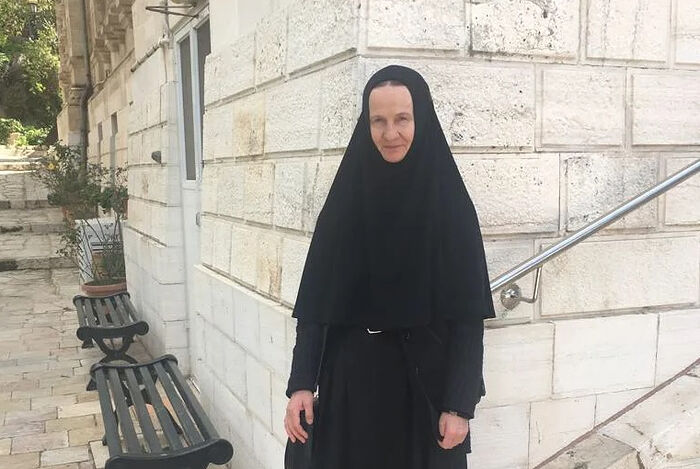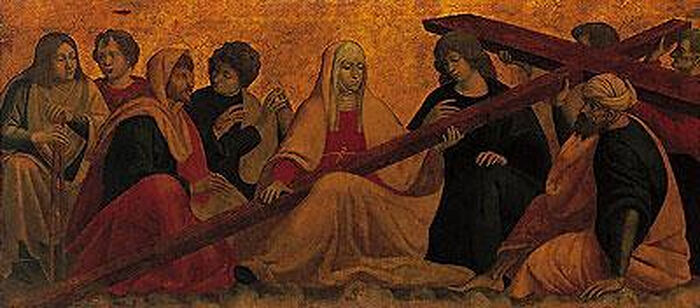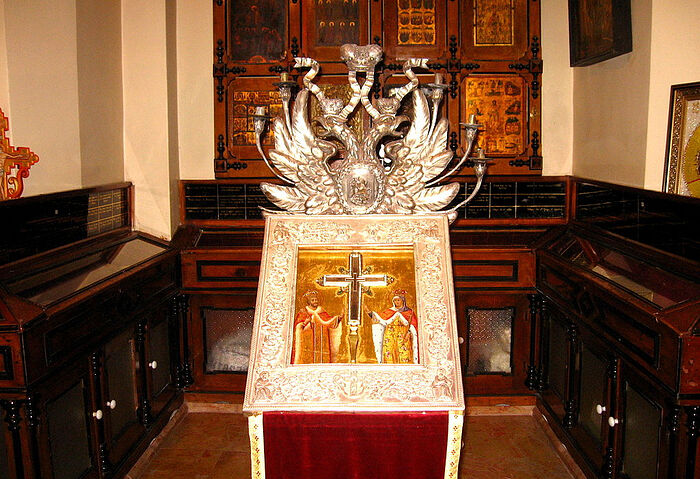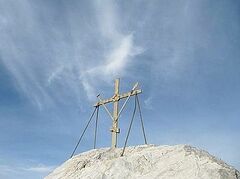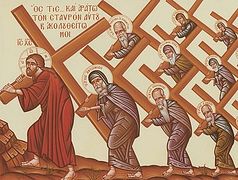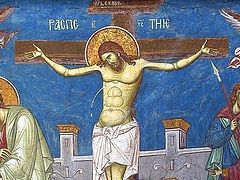The traditions connected with the place where the Life-Giving Cross of the Lord was uncovered and it’s, to say the least, complicated fate over the centuries, are the subject of our conversation with Nun Mariam (Yurchuk) of the Gorny Convent of the Russian Mission [Moscow Patriarchate] in Jerusalem—a guide and the author of a guidebook for pilgrims to the Holy Land.
—The feast of the Exaltation of the Cross is connected with the amazing event of the uncovering of the Lord’s Cross. But before we go on to that, I would like to ask you to tell us a little about the days that followed Christ’s death on the Cross and His Resurrection. The Savior was taken down from the Cross and buried. Where did the executioners take the instrument of His execution?
—In Judaism, there is a strict rule that is recorded in the Babylonian Talmud. Regardless of the form of execution (although crucifixion was not practiced among the Jews as a form of execution), the instrument used to carry out the death sentence had to be buried in the earth or even placed in the coffin with the body. But the Cross was huge. There was no time to saw it in pieces because the Jewish Passover was nigh. Therefore, the Cross was thrown into an old and long unused water collection cistern not far from the place of crucifixion, and covered with earth. The two other crosses of the thieves were also thrown there.
By God’s Providence, it was so arranged that this supreme Christian holy relic lay in the earth almost untouched. European historians write that the Cross was found by Queen Helen, but according to Syrian tradition, for example, the Cross was found by a certain woman. This is a minor detail, which is in fact makes no difference.
—The history of the uncovering of the Cross is inextricably connected with Queen Helen’s discovery of the Lord’s Sepulcher. Is there testimony about the first Christians gathering at these holy places, preserving them and praying at them?
—There is no direct testimony written by ancient historians. First of all, after the Lord’s Resurrection a strong opposition arose between those Jews who believed in Christ, and His enemies. Then there was the uprising of 66 A.D., wars began with Rome—the First Jewish war, then the Second...
There is testimony from historians that in later times, Christians made pilgrimages to the Holy Land. Origen, Eusebius of Caesarea, and others wrote about this.
But let us not forget that during the course of military actions Jerusalem burned many times. And, for example, the library that Bishop Alexander of Jerusalem gathered, where there were a large number of ancient manuscripts, possibly including testimony, perished—it was completely burned. Therefore, today history of that period is collected in bits and pieces.
—But Jerusalem Christians knew of the place where Christ’s Cross was hidden?
—The faithful knew about the place of Christ’s crucifixion and burial. Socrates Scholasticus reported this in his Church History: “Those who thought about Christ honored this sepulcher from the time of His passion.” Thus, the memory of the Lord’s Sepulcher lived in God’s people from the time of the crucifixion.
—Did only Christians know about this? There is after all a tradition about the “old Jew, Judas”, who remembered where the Cross was hidden.
—Almost all the historians have written about this: Judas pointed to the place where the Lord’s Cross was hidden. After its uncovering he came to believe and was baptized with the name Kyriakos (Kviriakos). Later he was consecrated a bishop, and received a martyr’s death for Christ during the reign of Emperor Julian the Apostate.
—What wood was the Lord’s Cross made from, and how was the Cross made? After all, having lain for three centuries in the earth, it was very well preserved. Apparently the other two crosses Queen Helen uncovered at the excavation site must have also survived, since those who found them were unable “by sight” to distinguish which of the three crosses found was the true holy relic. What does tradition say about this?
—The Cross of the Lord is a holy relic. The relics of saints remain incorrupt, and even more so could the instrument of our salvation not rot, even after lying in the earth for 300 years.
As for the wood from which the Cross was made... This is a task for Church archeologists.
There are many apocryphal stories circulating in Christian tradition. They have much in common with each other, because they are based upon the deep meaning of the Biblical words once spoken by the prophet Isaiah: The glory of Lebanon shall come unto thee, the fir tree, the pine tree, and the box together, to beautify the place of my sanctuary; and I will make the place of my feet glorious (Is. 60:13). This is a very touching and beautiful prophecy. Greek Catholics still embroider these words on their priests’ vestments.
Great significance is ascribed to this prophecy, and here is why.
The Tree of the Lord’s Cross is compared to the Tree of Life in paradise. For, through the Tree sin came into the world, when Adam and Eve tasted of its fruit. And here is a prototypical meaning, a link with the Tree of the Cross. The fruit of the new Tree, which blossomed on Golgotha, is the Body of our Lord. We receive this Body in the Sacrament of the Eucharist, and It brings us salvation in the full meaning of the word. This profound theological meaning lies at the foundation of a series of apocrypha on the theme of the Lord’s Cross, but they are the later ones. Although, these apocrypha were spread among the people and were translated into practically every language used to preach. In them there is a connection between the Tree from which the fall of Adam began, and the Tree through which we received salvation.
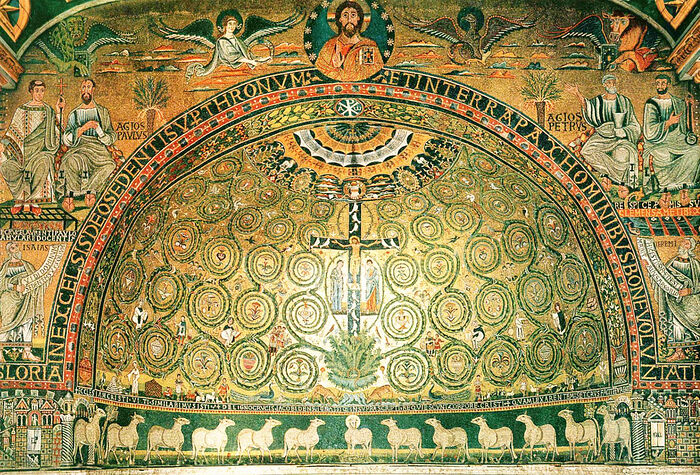 The Tree of Life. The apse of San Clemente.
The Tree of Life. The apse of San Clemente.
There is also a story of how the Holy Trinity, in the appearance of three Angels, visited Abraham in Hebron, and left three staffs at the Oak of Mamre—made of cedar, pine, and cypress that grew in the garden of Paradise. And after Lot, Abraham’s nephew, fell by sinning with his daughters, he came for advice to Abraham about what to do. Abraham blessed him to water the three staffs with water from the Jordan River until they began to grow leaves. Lot planted these staffs in the valley where a monastery now stands, and walked for water to the Jordan for a very long time, overcoming the obstacles and temptations placed in his way by the devil.
With time the three staffs grew leaves and formed a large, beautiful, triune trunk in the image of the Trinity. In the period of the construction by Solomon of the Old Testament Temple in Jerusalem, this tree was cut down, but they couldn’t use it because it continually changed in size. Tradition has it that the tree lay in the Sheep’s Pool, or Pool of Siloam, for nearly 900 years! Well, and when the time came for Christ’s suffering, they remembered Lot’s tree, and the Pharisees and scribes proposed making it into the instrument of our Savior’s execution. So goes the proverbial legend.
—The culmination of the uncovering of the Cross was its solemn exaltation after the miraculous resurrection from the dead and healing of the sick man by its power. Tell us about the place where the Live-Creating Cross was installed.
—It is located in the lowest point of the Holy Sepulcher Church complex, in an underground church. Formally this church belongs in our times to the Catholic church, but the Jerusalem Patriarchate, in connection with complicated historical circumstances, is conducting a legal battle over it. The place where the Cross was uncovered is adorned with a marble tablet with an inscription in Greek: “Jesus Christ, the Conqueror”. This inscription is dated to 1810. It is a very interesting place. Archeologists have worked there in our times and proved that even back in the period when King Solomon built the Jerusalem Temple, most likely stone was quarried from there to build it.
—What has happened from the moment the Lord’s Cross was found to our days?
—After the Cross was uncovered it became a supreme holy relic, and was kept in the Church of the Lord’s Sepulcher. There is testimony by pilgrims dated to the fourth century about the great reverence with which Christians venerated the Cross. There existed a whole rite of bowing down before it. A pilgrimess named Etheria, who visited Jerusalem in 380, describes the rite: Two deacons held the Cross so that no one could steal it. Incidentally, they were talking about the intersecting center of the Cross, because its other parts had been given to Constantinople and Rome. Pilgrims approached to venerate the Cross with great reverence. They pressed their foreheads and eyes to it, but no one dared to touch it with their hands. But there were also some unusual testimonies: Certain people when venerating the Cross would furtively bite off a little piece of the holy relic in order to take it to their homelands, so that their compatriots could share in the joy of venerating the Cross with their brothers returning from their long journey.
The fate of the Lord’s Cross is bound up with many wars. When the Persians came to the Holy Land, the Tree of the Lord’s Cross was taken as a war trophy by King Hosroe II. But fourteen years later, Emperor Heraclius devastated the Persians and returned the holy relic to Jerusalem. There is a touching story about this. Heraclius entered the city on a horse, wearing a royal diadem, arrayed in all the splendor of his royal robes, through the Golden Gates; but there he was stopped by an invisible power. An angel of God appeared to Heraclius and reminded him that that was not how Christ carried the Cross to Golgotha. The king understood that he lacked humility. So then he removed his royal garments, took off his shoes, put on a linen tunic, and walked barefoot into Jerusalem carrying the Cross on himself. From that time on, the Cross was kept in a special treasury.
Later, when the crusaders came to Jerusalem, the Greek clergy hid the Life-Creating Tree, fearful for the preservation of the holy relic. But the crusaders managed to find the Cross anyway. In 1187 the battle between them and the army of Salah al-Din took place in Lower Galilee at the foot of the “Horn of Hattin” mountain. In the Old Testament is described an event when the Jews took the Ark of the Covenant with them to battle, thinking that the Lord would help them in battle—not for their own sakes, as sinners, but for the sake of the holy shrine. In the same way, the crusaders took the ark with the Tree of the Cross into battle. The bishop from Akko stood on the mountain of Hattin with the Cross of the Lord, while in the valley a terrible battle was being fought between Christian and Moslems. According to the historians, 29,000 Crusaders died in that battle. Several Moslem fighters broke through to the mountain to the bishop and killed him. And so the Tree of the Cross was seized once again.
What happened after that? Both Moslem and Christian historians of the time remain silent about this, which is rather strange. Such a holy shrine, and suddenly it’s forgotten. There is one version that the European rulers bought the Wood of the Cross from the Moslems piece by piece. But these would have been unofficial deals, because there isn’t a word about it from the Moslem historians. So, the fate of the Jerusalem part of the Cross, it’s very center, is veiled in mystery. It is veiled in mystery just like the great Old Testament shrine—the Ark of the Covenant. In general, the history of the Jerusalem portion of the Lord’s Cross ends with the battle in Lower Galilee.
—Parts of the Life-Creating Cross were spread throughout the world. Is this holy relic in the Church of the Lord’s Sepulcher also?
—Yes, in the Church of the Lord’s Sepulcher is the largest part of the Cross that has come down to our days. It is preserved in the treasury of the church in a special reliquary. As for other particles, the largest one is kept in Greece, in the museum of the Greek Patriarchate.
The Cross reliquary and relic is usually carried out of the treasury on all the feasts, so that the faithful would be able to venerate it. Of course it is also brought out on the feast of the Exaltation of the Cross of the Lord.

